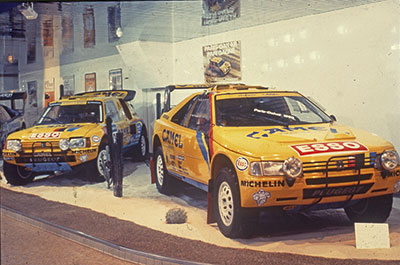-
MenuBack
-
COLLECTIONS
-
-
24h00 Le Mans
-
Alpine A110 1600S
-
Lancia 037
-
-
-
FULL KIT
-
-
FULL KIT
-
-
- ACCESSORIES
- Australian
- MAQMADON
-
Assembly guides
-
-
Blog Ixo
-
- FAQ
The Peugeot 405 T16 Grand Raid
At the 1988 Paris-Dakar Rally, the PTS team entered four cars with the mission of winning the event for the second time in a row. The objective was twofold, as it was also to highlight the new model of the Sochaux-based brand, the 405. The Peugeot 205 T16 and the 405 T16 Grand Raid will therefore take on the African tracks together. The 205 won the race masterfully in 1988 and the 405 scored a one-two in 1989.
When Group B cars were definitively banned from the World Rally Championship at the end of the 1986 season, Jean Todt, the director of PTS, decided to enter the 205 T16 in non-championship Rally-Raid races. After the numerous international successes of this model in 1987, Peugeot decided to develop a version with a longer wheelbase for the following season. Drivers often complained about the technical limitations of the car in certain race configurations. That year, the PTS team competed with the new 405 T16 Grand Raid, which coincided with the commercial launch of the production 405 saloon a few months earlier.

Ari Vatanen during the 1988 Pike's Peak American Hill Climb test, which he masterfully won.
© IXO Collections SAS - Tous droits réservés. Crédits photo © Peugeot
Entered in Rallye-Raid
At the beginning of 1986, the technical director of PTS, André de Cortanze, asked his design office to develop a car that could be entered in the Group S of the World Rally Championship in anticipation of the Group B suspension. As the 205 range had already been launched several years earlier, the car intended for Rally-Raids from 1988 onwards adopted the main bodywork lines of the brand's latest innovation. The 405 T16 was tested in the autumn of 1987 by the factory driver Ari Vatanen on the desert tracks of Niger and on the Lastours circuit in the south of France. For the Paris-Dakar race held the following January, the two cars were decorated in the same yellow as the 205 T16 by the sponsor Camel, and the 405 T16s stood out with their white and blue livery by Jacky Setton's Pioneer group. A true mechanical and technical perfection, the 405 T16 dominated the events in which it was entered, with victories in the Rally of Tunisia and the Atlas in 1988, the Pharaohs Rally and the Baja España-Aragón in 1988 and 1989, as well as the prestigious Paris Dakar in 1989 and 1990.

The Peugeot 205 and 405 Turbo 16 were to reign supreme in Rallye-Raid races from 1987 to 1990.
© IXO Collections SAS - Tous droits réservés. Crédits photo © Peugeot
Extrapolation of the 205 T16
The Peugeot 405 Turbo 16, which was to support the 205 T16 in Rallye-Raid races for the 1988 season, was not exactly a new car. It is rather an adaptation of the previous model from which it takes the mechanical solutions already successfully tested. The chassis was still a self-supporting monocoque with a tubular steel structure, while many body parts were made of carbon or Kevlar. The suspension is modified to accept a third Bilstein spring and damper combination at the rear of each wheel. The brakes are A.P. ventilated discs with four-piston calipers and two separate hydraulic circuits. The 1.9 litre engine, with aluminium alloy block and heads, is derived from the 205 T16. It is mounted centrally and transversely at the rear, inclined at 20°. The all-wheel drive system comprises a TJ-type 6-speed manual gearbox, combined with a hydraulically operated diaphragm clutch. This is complemented at both front and rear by a Ferguson-type limited-slip differential.

In the 1988 Dakar, Henri Pascarolo and Patrick Fourticq drove the second official Peugeot 406 T16 and finished 18th.
© IXO Collections SAS - Tous droits réservés. Crédits photo © Peugeot
The Pike's Peak version
For its entry in the 1988 Pike's Peak, the particular race conditions forced the Peugeot Talbot Sport technical team to modify the 405 T16, which had been used in Rallye-Raid, quite extensively. The chassis was lightened by 420 kg, thanks in particular to the removal of the bulky 425 litre fuel tank for a smaller one of 60. The 1.9-litre engine is similar to that of the Grand Raid version, but now produces 660bhp at 7,500rpm at the start of the event, with a maximum torque of 65mkg at 4,500rpm, but only 550bhp at the finish, due to the altitude. The specific Garrett turbocharger fitted has a boost pressure of 3 bar compared to the usual 2.2 bar. A water spray cooling system has been added. The transmission is four-wheel drive with a power split of 33% to the front and 67% to the rear. Three examples of this car were built.

The 405 T16, driven by Ari Vatanen, won the 1990 Paris Dakar, giving Peugeot its fourth consecutive victory in the event.
© IXO Collections SAS - Tous droits réservés. Crédits photo © Peugeot
Share this post





 Français
Français Anglais
Anglais Allemand
Allemand Espagnol
Espagnol Italien
Italien Portugal
Portugal